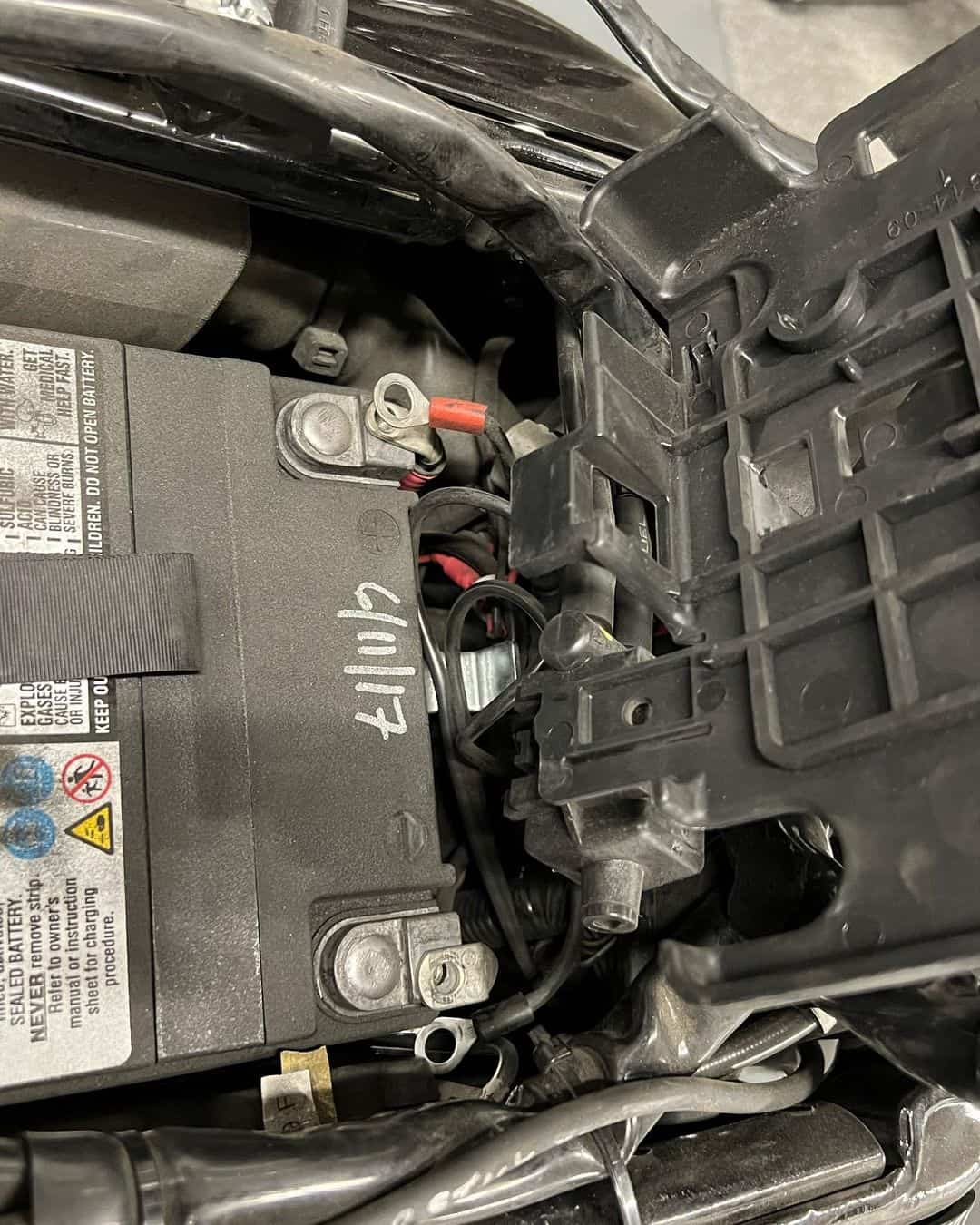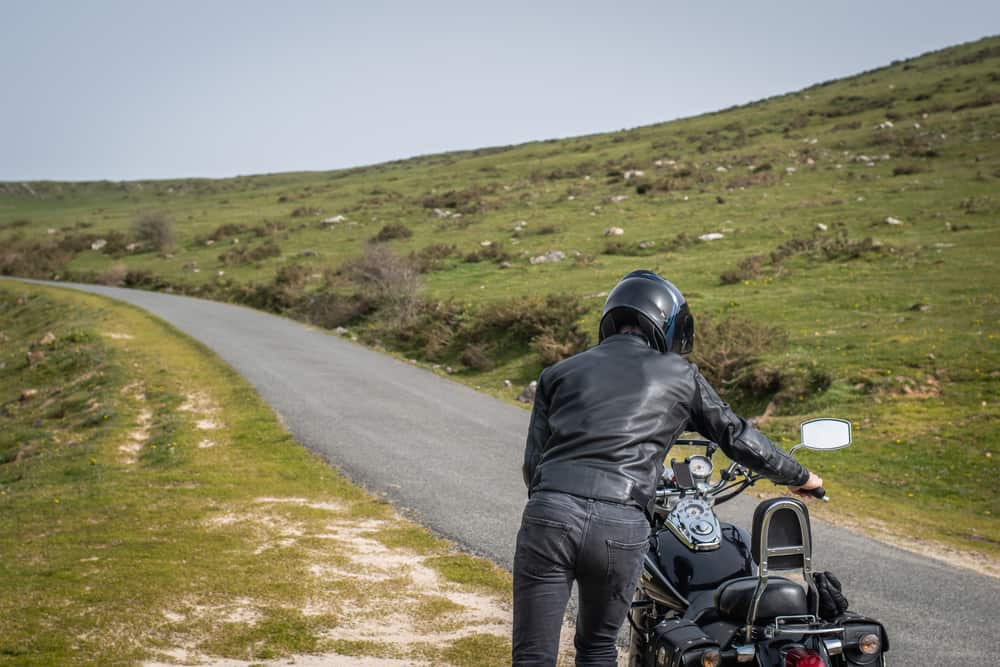Is your bike’s battery out of juice? Do you hear that awful click sound when you flick the switch? No need to worry; you can still start your motorbike and get to your destination without taking the bus or hitching a ride.
To start a motorcycle with a dead battery, you could push start your motorbike if it uses a carburetor. However, for motorbikes possessing fuel injectors or electronic ignition systems, the extra power that can be gotten from jump-starting a live battery from a car or bike or a jump starter is necessary.
If you’re not in a haste or worried about leaving your bike behind, you could simply connect your bike to a charging outlet and come back for it later. However, if you need to move immediately, here’s how to get the motorbike started and ready to go.
Table of Contents
How to Start a Motorcycle with a Dead Battery?
There are two effective techniques you can adopt to start a motorcycle with a dead battery. They include:
- Jump starting
- Bump Starting
Jump-starting
Using this technique, with a portable jump starter or live battery gotten from another motorcycle, starting your motorcycle is possible. This method is quite reliable provided the battery in question has a rating of 12 V and is in pristine condition.
The procedure for jump-starting a motorcycle with a dead battery is quite similar to the way you’d jump-start a car. The only differences are the location of the batteries and how to access the terminals. three ways to jump-start a bike and to achieve this you’d need the following items:
- Good battery or Jump box
- Jumper wires
1. Using Jumper Boxes
Every biker needs a jumper pack. It is simple, safe to use, handy, and also cost-effective. This portable unit solves the problem of a dead battery without any hassle.
Here are the general steps, but if you want to do it right, refer to the manufacturer’s instructions included with the jump starter.
Step 1: First, ensure the jump starter and your motorcycle are switched off.
Step 2: The jump starter has two leads from the sides among an array of assortments. These leads are like the clips on conventional jumper cables. Connect the red positive lead to the positive terminal of your bike’s battery first. Then attach the black negative clip to a grounding spot on the bike. This can be any bare unpainted metal surface of the bike’s frame.
You can connect the clips to the chassis’ terminals if you can’t locate the battery terminals. This is where the battery is connected to the motorcycle.
Step 3: Set the charging configurations. Some units have multiple charging settings you can adjust to suit different batteries. Adjust the settings to the voltage appropriate for your battery. It should be set to 12 V, for instance, if you have a 12-V battery.
Step 4: After setting the rate and voltage, switch on the jump starter and start your bike. Jump starters deliver high quantities of amperage in short bursts, enough to crank the engine almost immediately. If you crank for more than 2 to 3 seconds at a time, you’d quickly exhaust the power in the jump starter.
Allow the jump starter to cool and recharge for a few minutes before starting your motorcycle again if it doesn’t start immediately. Suppose your bike doesn’t respond favorably after several tries. In that case, the battery is probably either wholly dead or unable to hold a charge.
Step 5: Once the bike is up and running, detach the cables by removing the negative clip before the positive clip. Leave your bike running or ride it around at high revs for a few minutes; this will help power up the battery. You may not need to do this if you’d be replacing the battery soon.
2. Using Another Motorcycle

To jump-start off another motorcycle:
Step 1: Ensure both motorcycles are turned off, safely parked, and in neutral.
Step 2: Detach the covers of the terminals of the batteries and attach the jumper cable in this order. Attach one clip of the red jumper wire to the dead battery’s positive terminal. After this, connect the other clip of the same wire to the live battery’s positive terminal. These terminals usually have red covers and a plus, P, or POS sign.
Step 3: Next, attach one clip of the black jumper wire to the live battery’s negative terminal. This terminal usually has black covers and a minus, N, or NEG sign close to it. Then, connect the other clip to a bare unpainted part of the bike’s frame with the dead battery.
Step 4: Start the donor bike and keep the motor running for a while to get the charge high before starting your own motorbike. This alone may suffice if your motorbike uses a carburetor.
For most modern motorbikes, it is a bit different. These bikes usually have fuel injectors and an electronic fuel pump. The fuel system needs to be primed with fuel. Or else the motorbike won’t start. Once it is primed, you can hit the ignition.
Step 5: Remove the clips of the jumper wires; black first and red last. Do this while your bike is still running.
3. Using a Car
It is possible to jump-start your bike with a car’s battery, provided both of them use a 12-volt negative-to-ground electrical system. Or else you may fry your bike’s electrical system and damage its battery. This is because car batteries have higher amperage than those motorcycles.
Delivering that much power would overload the battery and burn the ignition switch. We don’t recommend jump-starting with a car unless there is no other option. You must ensure you won’t deliver that too much power too quickly from the car to the bike’s battery.
Jump-starting your bike with the battery from a car is almost the same procedure as described above. Follow those steps but never start the vehicle, or you’ll burn your bike’s electrical system. Also, the location of the batteries is different.
Key Takeaway
- Don’t connect the other clip of the negative cable anywhere near the dead battery, or it will cause sparks that may cause a fire or explosion because of the hydrogen gas emitted.
- Jumper boxes are the most reliable because they’re portable, have inbuilt safeguards, and can also be used to charge your mobile phones and other accessories.
- Jump starting with a power pack drains its charge level, so always recharge the battery pack after each use and once every six months when not in use.
Bump Starting
Bump starting, pop starting, catching it in gear, or push start is a tried-and-true technique for starting a bike’s engine when the battery is dead or if faced with a malfunctioning starter. You can efficiently perform this task alone while riding a motorcycle, without needing any special tools or jumper wires.
You only need the following:
- Your bike
- Loads of strength or an assistant
- An empty street or a slope, if you get lucky.
Although you should be able to push start, you rarely need to. Still, here’s how to do it:
Step 1: Check all the basics to confirm that it is indeed a dead battery problem. Then, flick the ignition switch on.
Step 2: Put your manual choke in the usual position for a cold start if you have one.
Unless you’re riding a sports bike with a high first gear, shift into second gear on the bike. We recommend second gear because it is both simple and safe for most bikes. You can also start in neutral because it facilitates the next step. First gear can be too aggressive for some motorcycles. We don’t recommend using it because the bike might jerk forward and throw you off.
Step 3: Engage the clutch and start pushing your bike while walking beside it. If your vehicle has a lot of clutch drag, you might want to keep it neutral until you reach top speed. However, this adds extra work because you’ll need to shift it into gear before the clutch drops.
After pushing, set off in a sprint if you’re doing this alone. If you have someone helping you, climb the bike and ask your assistant to move you forward slowly and as quickly as possible.

Step 4: When you reach a top speed, quickly jump onto the vehicle with your left foot while avoiding the gear lever. Then release the clutch abruptly; if you feather it, it will only serve as a brake. To give the rear some extra traction, time the clutch snap with sitting down in the saddle. Give it only a tiny amount of throttle if that’s what the bike typically needs to start.
Step 5: Reverse the clutch almost immediately. If you simply leave the clutch out, you run the risk of coming to a grinding halt if the engine catches and of speeding along at top speed otherwise. You’re basically popping the clutch this way in and out.
Step 6: Once you’ve gained enough speed, put the bike in second gear if you begin in neutral. Keep the engine running once the motor starts by revving or letting it warm up on the choke. Do not stall or stop the bike. If the bike doesn’t respond favorably, try again.
You need a long clear stretch of road for some traction. Also, doing this on an empty street is best, so you don’t get run over by a bus or lorry. This method will not work if your ride is a Honda motorcycle with DCT or a scooter because automatic gearboxes cannot be bumped.
Key Takeaway
- Having someone assist you with pushing is a lot easier for you to attain top speed.
- Alternatively, you can let gravity do the job for you by rolling the bike down a slope or a hill if you’re lucky.
Final Thoughts
Starting a bike with a dead battery isn’t all that hard or risky. You can try to bump starting if your motorcycle has a carburetor. Still, you’d need more than that if you’re riding a fuel- or electronic-injected bike. You can jump-start it off a good battery from a car or bike or use a jumper box. Also, taking your battery for a later diagnosis is best to prevent this problem from happening again.
